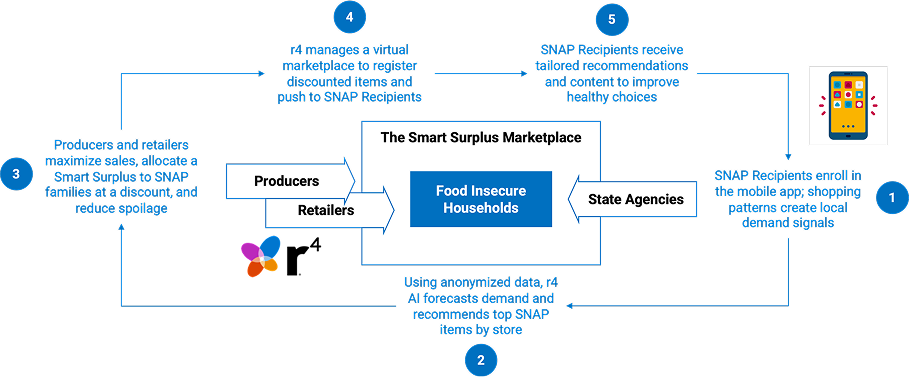Each year US Federal and State Governments spend roughly $250 billion on nutrition assistance, while producers and retailers throw away an equivalent amount of surplus food. r4 has led in the creation of a public-private partnership to leverage data and AI technology to modernize government programs to align supply and demand, multiplying by 2-3x the purchasing power of nutrition assistance dollars while allowing producers and retailers to significantly reduce waste and costs and grow profits.
r4 AI will enable SNAP Smart Surplus by connecting demand & supply via existing industry best practices

~$250B surplus food at Producers and Retailers with no efficient, scalable outlet

Manufacturer and retail discounts delivery through digital apps is widely adopted

41 million SNAP Recipients (12% of US ) spend >$20B per month, with funds often running out by mid-month

Recipients often don’t have the knowledge and experience to make the healthiest choices
SNAP Smart Surplus Components
Conceived of by r4
This program was introduced at the September 2022 White House Conference on Hunger, Nutrition, and Health and has received support from the Biden Administration Office of Public Sector Engagement, the USDA, the CDC Foundation, The University of Florida, and other leaders in topics of nutrition and food security as a bold and innovative approach to improving the efficiency and effectiveness of nutrition assistance programs. The program was approved by the US Department of Agriculture Food and Nutrition Service (FNS) to allow retailers to offer special incentives to SNAP recipients.
Announced publicly as the Smart Food Program in Delaware in July 2024, the program is focused initially on the Supplemental Nutrition Assistance Program (SNAP), the largest Federal nutrition assistance program. Delaware is the first state to sign up for a multi-state pilot program. Virtually every state contacted to date has expressed strong interest in participating, and several states are in the process of seeking funding. As expected, each state is dealing with budget challenges.
AI-enabled SNAP will use aggregated demand to align excess supply to feed citizens with need and increase producer and retailer profitability
The opportunity: align digital best practices and government policy to create a Smart Surplus Marketplace driving improved Retailer Profitability and increased value of SNAP benefits
The Outcome: 2-3x greater SNAP buying power for healthier food, while also…
- Providing better forecasting predictability for retailers and producers for the most perishable products
- Reducing out-of-stocks and over-stocks
- Improving profitability for producers and retailers
- Reducing food waste
- Improving health outcomes
- Promoting sustainability
AI-enabled SNAP will use aggregated demand to align excess supply to feed citizens with need and increase producer and retailer profitability

“priceline for food”
Leveraging AI technology to drive innovation in Nutrition Assistance across agencies and programs
Endorsed by The White House as part of the Conference on Hunger, Nutrition, and Health
Starting with
SNAP “Smart Surplus”
Matching the $250B SNAP demand to the $250B of to-be-wasted food
Supported by
SNAP Education Digital Engagement
Pilot Program funded by USDA, University of Florida, and the Florida Dept of Children and Families
Scaling to Comprehensive
Federal Nutrition Assistance Innovation
SNAP | WIC | School Lunch | Community-based Feeders

